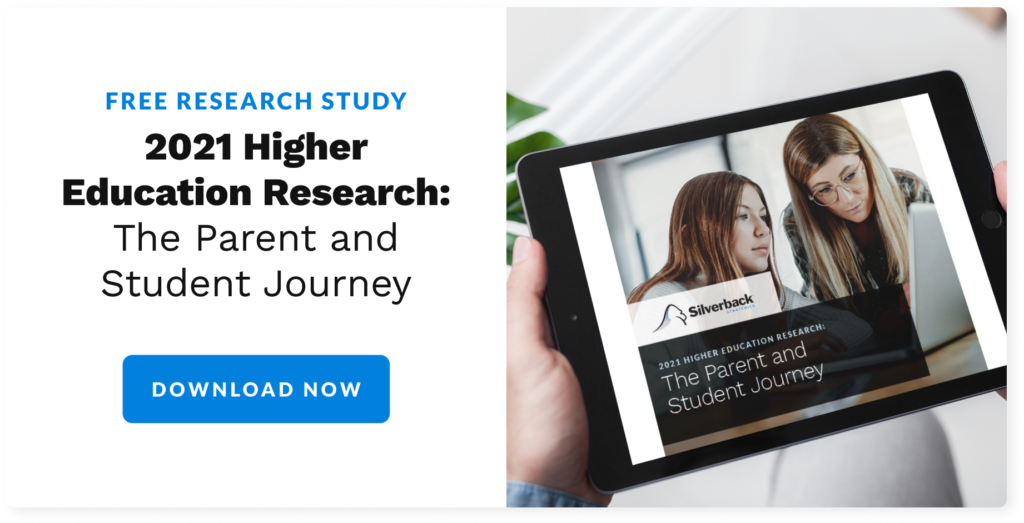Table of Contents
The college application process has, like almost everything, become an online exercise that requires SEO expertise. Schools used to be able to rely on students to come to them. Institutions of higher education have spent the past few years revamping strategies to be more proactive in recruiting students.
Instead of waiting for students to find your school, your school can find prospective students and put your best foot forward, so to speak, before they even get to campus. What families of prospective students may have thumbed through a hard copy magazine to find a decade ago, they now type into search engines and interact with on search engine results pages (SERPs). What used to be done through the mail is now accomplished with search engine optimization and paid media advertising.
SEO for Colleges: It really is *that* important
Undergraduate enrollment decreased by 2.5 percent in the fall 2020 semester, according to data released by the National Student Clearinghouse Research Center.
But this isn’t just a pandemic-related problem. Panic around enrollment numbers is a stress point many higher learning institutions share. Only 36% of public universities and 29% achieved their enrollment goals by May 1 in 2019, according to an Inside Higher Ed survey. Only 48% of schools in the survey met their goals by July 1. An overwhelming majority of public universities and private colleges said they were either “moderately” or “very” concerned about their enrollment numbers.
In the same survey, only 11% of administrators said they were “very satisfied” with the marketing tools their school used.
If you’re not satisfied with your enrollment numbers, that means it’s time to get more proactive. It’s never been more crucial to find students instead of waiting for them to come to you. That’s where your school’s SEO strategy comes in.

Before we go any further, there’s one thing you absolutely have to keep in mind when thinking about your school’s SEO marketing campaign strategy
Your enrollment season. As in: when do you want someone who clicks on your links to actually start school? Your school’s answer to this question will change throughout the year. Seasonality can have a huge impact on your search traffic. This is true in many industries, and higher education is no exception.
Maybe your main enrollment season is in the spring, around March through April, with a smaller enrollment season coming in the fall, around October and November. Your school’s enrollment season might not be the same as another’s. That’s fine! You’ll just want to define your enrollment season before you sketch out your full SEO marketing plan.
How SEO works in higher education marketing: A quick primer
I’ll explain some of the finer technical points below, but here’s how search engine optimization factors into the marketing strategy of many colleges and universities around the country.
Organic search engine optimization will be the backbone of your strategy. A school’s website should have blog posts that are designed to appear at or near the top of a search engine results page. They do this by providing answers to the questions potential applicants might search for. (Your school’s website might also need a technical SEO audit to fix any issues on the back end that could prevent your content from achieving its full potential.)
Capture your school’s target audiences and continue to feed them the content they’re looking for. This will ensure you are set up for long-term success.
Read more: Everything You Need to Know About Editorial SEO
However, to prime your school both for a successful enrollment season and a proper long-term presence on search engine results pages, you should have a paid media strategy and an SEO strategy.
This is because while optimizing every inch of your website for search ensures you get in front of the right audience year-round, paid media occupies a slightly different role. During your prime enrollment season, you want to capture all the potential students you can. While organic SEO can nurture a potential student on that specific student’s more leisurely decision-making timeline when you’re not in your enrollment season, a paid advertisement might be what your school needs to target prospects more proactively and turn them into applicants. There’s a lot that goes into a paid media strategy, but suffice to say your overall search strategy could be incomplete if you don’t have one.
Your competitors might take advantage of paid media already. If so, your school will be at a disadvantage if it doesn’t have a Google Ads strategy. And if your competitors don’t have a robust paid media strategy, well, here’s your opportunity to leapfrog them on the search engine results page.
While organic SEO can nurture a potential student on that specific student’s more leisurely decision-making timeline when you’re not in your enrollment season, a paid advertisement might be what your school needs to target prospects more proactively and turn them into applicants.
The finer points of SEO keyword strategies and the role they play in the higher education marketing process
The key to any successful keyword strategy is targeting users throughout their decision process, and that’s no different in the higher education space.
Your SEO keyword strategy should strike a balance between targeting broad, highly searched, competitive keywords, and more detailed keywords that are specific to the programs you offer.
A comprehensive keyword strategy increases the likelihood of reaching your relevant audience, as you can get in front of users searching for something broad such as “bachelor’s degree” or as detailed as “computer science bachelor’s degree.” Program-specific keyword strategies are a critical component of driving enrollments.
Once you have your program-focused keyword strategy in place, it’s time to focus on your blog.
Choosing a college program is a big decision, one that users are going to put a lot of research into. Your blog is a great place to create content that answers common questions such as “How to choose a college major?”
A program-specific keyword strategy combined with a thorough blog keyword strategy gives you the comprehensive keyword strategy needed in order to succeed in this always evolving search landscape.
Your school’s website will need content that satisfies robots and real humans. For that to happen, SEO and content strategy need to work hand-in-hand for your school to achieve its goals, whether that content team is in-house or at an agency. SEO experts can advice content writers to strategically place keywords in places that matter, such as title tags, meta descriptions, H1s and body copy, and to avoid keyword stuffing.
What is the right combination for you?
Silverback Strategies worked with eCornell, Cornell University’s online learning platform, to perfect an SEO strategy. The institution rolls out new programs every month, making organic search a crucial part of their success on highly competitive search engine results pages.
After our initial technical audit, eCornell increased its search volume for keywords in the critical 1-3 positions on search engine results pages by 382 percent, and its domain authority spiked 30.4 percent over the course of our partnership.
Read the full case study here.
“We loved working with (Sr. SEO Manager) Mat Ingham and his team,” said Megan Burke, CMO at eCornell. “We rarely go outside the house to work with an agency. This was a unique case. Silverback had a lot of interesting ideas and were great partners for us.”
Silverback Strategies has helped colleges level up their SEO. We can do the same for you
At Silverback, we know how crucial search engine optimization is to higher education marketers. We’ve helped colleges and universities correct structural problems to put their best foot forward on search engine results pages, and we have the results to prove our efforts work.
Our aggressive approach to search engine optimization provides clients with the expedited SERP performance that a business needs for growth. Working in tandem with our Creative Team allows our SEO experts to address Technical SEO issues, identify key areas of organic search opportunity and produce the assets needed to rank higher, faster.
Interested? Contact us today.


